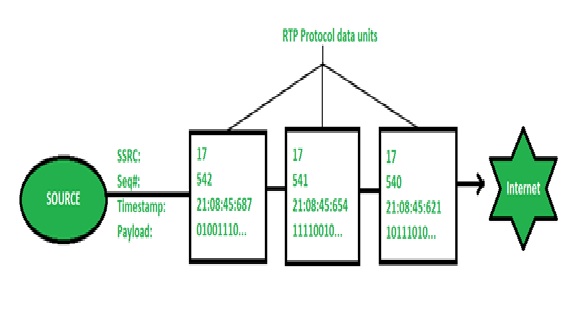Significance of real-time transport Protocol in VOIP
Real-time Transport Protocol (RTP) – a streaming media protocol, describing how audio and video packets should be formatted and transmitted over an Internet Protocol (IP) network. Typically it’s used in conjunction with the RTP Control Protocol (RTCP) protocol in a VoIP network.
RFC 1889 and RFC 1890 cover the Real-time Transport Protocol (RTP), which provides end-to-end delivery services for data with real-time characteristics, such as interactive audio and video. Services include payload type identification, sequence numbering, time stamping and delivery monitoring. The media gateways that digitize voice use the RTP to deliver the voice (bearer) traffic.

Figure 1. Significance of real-time transport Protocol in VOIP
Figure 1 shows The role of RTP is to ensure a uniform way to transmit data subject to real-time constraints. For this purpose, RTP injects time markers and sequence numbers to the various multimedia streams (audio, video, etc.), controls the destination arrival of the packets, and identifies the type of information transported. However, this protocol cannot reserve resources in the network, provide reliability in the network, or guarantee delivery time.
RTP (Real-time Transport Protocol ) Works in VOIP
RTP can be described as a UDP add-in that adds to each transmitted packet valuable information about the sequence number (which will put the received packets back in order) plus a packet timestamp for the database restore. Of time. Thus, the receiver of information knows the date on which a packet was sent and can measure the time spent in the network to reduce the transmission time by comparing the transmission times of several packets of the same exchange.
RTP is managed at the application level. Its purpose is to provide end-to-end transport functions for real-time applications over multicast or unicast network services (audio conferencing, interactive video/video broadcasting, audio/simulation). The primary role of RTP is to implement IP packet sequence numbers to reconstruct the voice or video information even if the underlying network changes the packet order. From a technical point of view, RTP allows:
– Reconstitute the time base of the audio, video, and real-time data streams in general.
– Quickly detect packet loss and inform the source in a time compatible with the service.
Applications of RTP:
- RTP mainly helps in media mixing, sequencing and time-stamping.
- Voice over Internet Protocol (VoIP)
- Video Teleconferencing over Internet.
- Internet Audio and video streaming.
References:
- https://www.sdxcentral.com/resources/glossary/real-time-transport-protocol-rtp/
- https://www.geeksforgeeks.org/real-time-transport-protocol-rtp/
- https://www.pbxdom.com/blog/engineering/how-rtp-real-time-transport-protocol-works-in-voips
Cite this article:
Thanusri swetha J (2022), Significance of real-time transport Protocol in VOIP, AnaTechMaz, pp. 65















